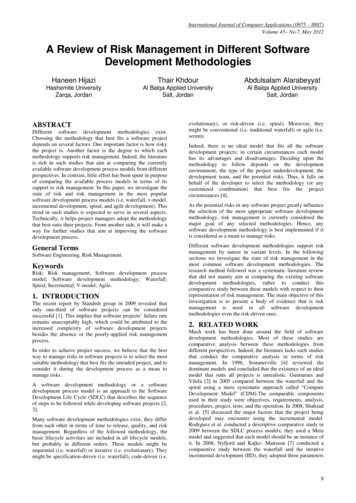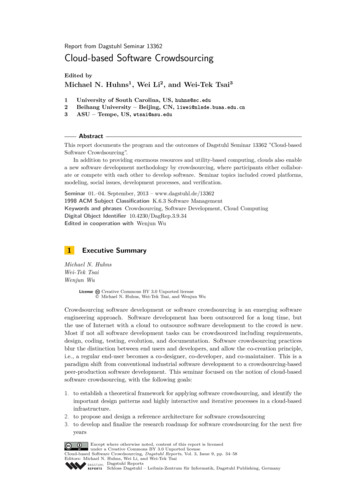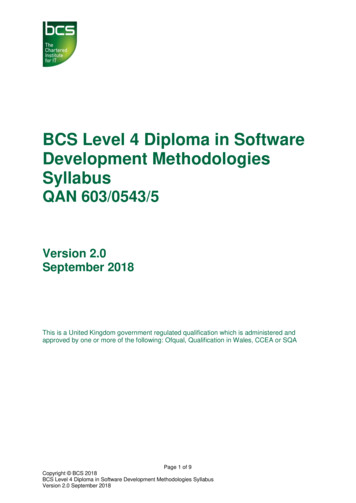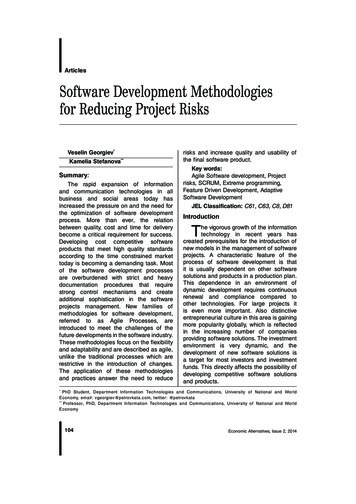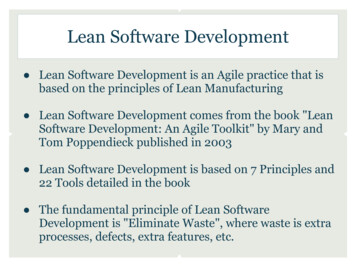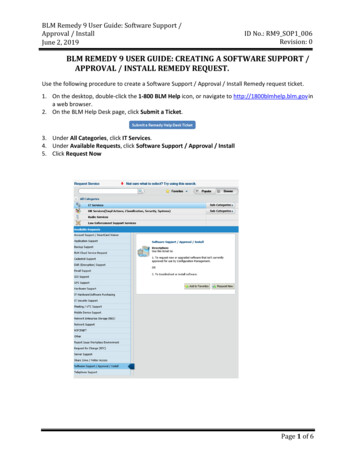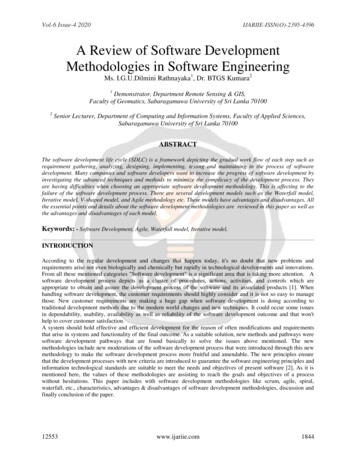
Transcription
Vol-6 Issue-4 2020IJARIIE-ISSN(O)-2395-4396A Review of Software DevelopmentMethodologies in Software EngineeringMs. I.G.U.Dilmini Rathnayaka1, Dr. BTGS Kumara21Demonstrator, Department Remote Sensing & GIS,Faculty of Geomatics, Sabaragamuwa University of Sri Lanka 701002Senior Lecturer, Department of Computing and Information Systems, Faculty of Applied Sciences,Sabaragamuwa University of Sri Lanka 70100ABSTRACTThe software development life cycle (SDLC) is a framework depicting the gradual work flow of each step such asrequirement gathering, analyzing, designing, implementing, testing and maintaining in the process of softwaredevelopment. Many companies and software developers want to increase the progress of software development byinvestigating the advanced techniques and methods to minimize the complicacy of the development process. Theyare having difficulties when choosing an appropriate software development methodology. This is affecting to thefailure of the software development process. There are several development models such as the Waterfall model,Iterative model, V-shaped model, and Agile methodology etc. These models have advantages and disadvantages. Allthe essential points and details about the software development methodologies are reviewed in this paper as well asthe advantages and disadvantages of each model.Keywords: - Software Development, Agile, Waterfall model, Iterative model.INTRODUCTIONAccording to the regular development and changes that happen today, it's no doubt that new problems andrequirements arise not even biologically and chemically but rapidly in technological developments and innovations.From all these mentioned categories "Software development" is a significant area that is taking more attention. Asoftware development process depicts as a cluster of procedures, actions, activities, and controls which areappropriate to obtain and assure the development process of the software and its associated products [1]. Whenhandling software development, the customer requirements should highly consider and it is not so easy to managethose. New customer requirements are making a huge gap when software development is doing according totraditional development methods due to the modern world changes and new techniques. It could occur some issuesin dependability, usability, availability as well as reliability of the software development outcome and that won'thelp to cover customer satisfaction.A system should hold effective and efficient development for the reason of often modifications and requirementsthat arise in systems and functionality of the final outcome. As a suitable solution, new methods and pathways weresoftware development pathways that are found basically to solve the issues above mentioned. The newmethodologies include new moderations of the software development process that were introduced through this newmethodology to make the software development process more fruitful and amendable. The new principles ensurethat the development processes with new criteria are introduced to guarantee the software engineering principles andinformation technological standards are suitable to meet the needs and objectives of present software [2]. As it ismentioned here, the values of these methodologies are assisting to reach the goals and objectives of a processwithout hesitations. This paper includes with software development methodologies like scrum, agile, spiral,waterfall, etc., characteristics, advantages & disadvantages of software development methodologies, discussion andfinally conclusion of the paper.12553www.ijariie.com1844
Vol-6 Issue-4 2020IJARIIE-ISSN(O)-2395-43961. Waterfall ModelThis method can be introduced as a traditional methodology in Software development. It is a sequence process ofdevelopment and the development progress estimated according to consecutive phases which are showing anincrement downwardly as a waterfall flowing. It emphasizes particular planning and comprehensive documentationas the outputs[3]. During this process, each and every initial stage begins after completion of the former stage and itis a linear sequential flow of activities. Due to this reason, the Waterfall model is recursive during each phase to getthe perfect outcome and until it delivers a perfect outcome. After completion of each stage, that stage holds its ownand specific deliverables. This is a software development procedure or architecture which possible to predict theforthcomings using the software development plan. The feedback of the project owner could collect after completionof development and testing stages. This methodology is applicable for slight software development projects whichconsists of undisturbed requirements with clear and easy planning.1.1 Advantages of Waterfall MethodologySimplicity and easiness in using and understanding is one advantage of using this methodology. Convenientmanagement of methodology which helps to proper and specific deliverables at each phase as well as review theprocess when it's completed. This methodology is more productive when using for small projects which consist ofclear and sufficient requirements. Each phase is completed within a given specific period before moving to the nextphase which depicts a clear progression of the development project. Convenient implementation due to the linearflow of this methodology is another strength of this methodology. Implementation could proceed with the minimumamount of resources. Appropriate and proper documentation assist to enhance the quality of end result as well as thedevelopment procedure.2.2 Disadvantages of Waterfall MethodologyCouldn't gain any working software until all the parts of the life cycle are completed. The availability of more riskand irresolution is a fact to consider here. This methodology is not suitable for large, complicated and objectoriented projects. This methodology could affect project failure if apply for the projects which consist of high-riskmoderations. One phase of the development process starts after completion of the former phase and couldn'timplement any changes after completion of a phase. This occurs for customer dissatisfaction2. Agile Software Development MethodologiesA software development methodology can define as a proper guidance to maintain successive development process.In addition to that, it is a set of arranged tasks engaged with functions of software development process as well as itconsists of structure to entire development activities. A software development methodology render the planning,analysis, design, development, implementation, testing and the maintenance of the process of software developmentby contributing suitable rules and guidelines. These methodologies help to manage a software project.There are no one and default methodology which suitable for every situation [4]. The reason for that is the softwareprojects are different from each other as well as it's characteristics, resources that using, the development tools thatuse are slightly having variations. It's important to select the suitable and appropriate Software developmentmethodology considering the attributes and nature of the project. The success and result of the project end productdepends on choosing the appropriate software development methodology. And it helps to work before deadline, costmanagement, make a better client satisfactory, expenditure minimizing, etc. Considering these points, it's importantto choose the best and most suitable software development methodology for the project. Some of the basic agilesoftware development methodologies are discussed in this paper.2.2Agile ProcessAgility in simply depicts to strip away the heaviness, usually associated with traditional software developmentmethodologies, in order to accelerate the quick response for altering environments, modifications in userrequirements, work before project deadlines.[5]. Agile methodologies give more attention to the development of thesoftware than documentation. This methodologies trends to supply more work during its iterations and to use thefeedback of the clients or customers to upgrade the software. This development methodologies way better suitable toenhance the ability to make changes in user requirements until the user or customer satisfaction about the final12553www.ijariie.com1845
Vol-6 Issue-4 2020IJARIIE-ISSN(O)-2395-4396product, rapid and effective development all over the development process as well as the incremental releasesduring a short time. This method usually applicable to law number of project teams, mostly for less than tenmembers. The reason for this is the team members must get tin to face to face interviews or discussions often. It'sbetter to choose a team representative when using these methodologies. A disadvantage of agile methods is notapplicable in large teamwork areas.Followings are the different methods in agile methodologies Extreme ProgrammingSCRUMCrystal family methodologiesFeature-Driven DevelopmentDynamic Systems Development MethodAdaptive Software DevelopmentOpen Source Software developmentAgile ModelingPragmatic Programming2.3 Extreme ProgrammingExtreme Programming (XP) has gradually grown from the issues that occurred with the long development cycles oftraditional development models [6]. This method began as a well-planned structure to finish the work with thesuccessive and effective procedures all over the software development process. With the completion of remarkableexperimental trials, this XP methodology was chosen to make "theorized" and usage. When using this method, thedevelopers could work as pairs for the non-stop code segments. Using this method, it could gain robust finalproduct with more quality as well as it could take double expenditure on the development process. This is adisadvantage of XP method.2.4 SCRUMThis is the most famous method in agile methodologies. It consists of small sprints (7-30 days) and the featurescould add during this sprint while conducting suitable meetings for better development. It's better to use a scrumboard which helps to mention the tasks of the project. This method is ensuring the proper management indevelopment process.It is an innovative approach of industrial development process, applying development life cycles resultingreintroduction of more flexibility, adaptability and productivity [7]. Scrum depicts how to provide the functionalityof team members to gain a flexible system. Scrum directs to magnify and strengthen the current engineering aspects(e.g. testing phase) of a software development process, allowing considerable management on privations or barriersall over the process and its utilization.2.5 Crystal family methodologiesThis crystal family methodologies consists of various methods to choose the appropriate methodology for theselected project. Each and every team member of the crystal family, selecting different colors according to theworkload assigned with. The dark colors were chosen for the heavier methodologies. Crystal family is gathering ofagile software development methodologies which are possible use for diverse software projects depending on size,complexity, risk managing ability and number of people involved [8]. Crystal orange is aim for the projects whichconsisting maximum of 40 developers [9]. The project development period is last about two years. The projectperiod is frequently about one to two years.2.6 Feature-Driven DevelopmentIt is an iterative development process. The FDD approach is not wrapping the whole software development process,but relatively aims on the design and building of phases [10]. FDD made to engage with co-operative activitiesduring a software development process and avoid to utilize any significant process model. This approach involvedfor effective and efficient development of the project with better practices.12553www.ijariie.com1846
Vol-6 Issue-4 2020IJARIIE-ISSN(O)-2395-4396FDD contained five sequential processes while demonstrating the suitable methods, techniques, and guidelineswhich were useful for the stakeholders. The roles, artifacts, objectives, and goals were mentioned in this method.FDD depicts the most appropriate be for the development process of a project.2.7 Dynamic Systems Development MethodDuring this method, it settles the whole time it takes for the development, cost that would take and the quality. Thismethod is allowing to take the project development to a finite and strong pathway. The basic view of DSDM is thatwhen making the functions of the system, it increases the time period and resources to achieve that function. It isbetter to choose a fixed period and the required resources before adding more functions. This method suitable forprojects when it considers the project time period, the cost for the development process, and the quality of the finalproduct more specifically than the completion of the features of the project successively.2.8 Adaptive Software DevelopmentAdaptive process model is a modified approach of XP model, which is the most widely used agile model [11]. ASDtargets on the issues of the complex software development process mostly in the large systems. This methodemphasizes the progressive and stage-wise development with stable prototyping. Furthermore, the ASD supplyframework or an approach holding suitable enough guidance to avoid projects, but it should consider that it doesn’tprovide much guidance to trample the creativity.2.9 Open Source Software developmentThis is an innovative way of software development method. There are significant variations between this model andother respective models, about the flow of software development, adding modifications, reuse, and redistribute thesoftware [12]. Open source developers are involved in a variety of activities such as designing, coding,debugging and utilizing [13]. This method defines as the traditional theoretical method that the programmers happywith writing, rectification and testing the software reducing the straight decrement. This method nominates freesource code to be freely available for amendments and expanding the facility to modifications. Eventually, thedevelopers who are using this methodology, won't gather and discuss the matters in the development process. Thismethod can be named as a combination of distinct licenses for software development as well as a co-operation forthe personals who develop software with regular progress. OSS doesn’t hold the proper defined and expressedsoftware development procedures with a formation of a written descriptive method. OSS consists of extensivetesting which can be introduced as an advantage and it's due to the reason that the codes are examined by severaldevelopers. It's benefits for the developers who work in different locations in the same project. In this method, thereis no project owner to give feedback. OSS methodology is applicable for slight, medium and wide-scale projects.2.10 Agile ModelingAgile Modeling is an innovative method introduced by Ambler during 2002. It is a fresh pathway to accomplish theactivities of the software development process. This method basically targets to procedures and traditional policies.This method focuses to minimize the documentation which involves the development process while inspiringdevelopers to produce successive models and even in design parts of the process. The significant attention goes toproper communication with team members according to team structures with co-operative teamwork.The basic element of agile modeling can be expressed as functioning the software. Agile Modeling is highly targetedtowards to practices or procedures. It consists of basic eleven practices that are mentioned under four sections asiterative and incremental modeling, teamwork, simplicity, validation. These practices providing better ways to selectan appropriate methodology for the development as well as for manageable teamwork. Moreover, eight additionalwere defined under three categories like productivity, documentation, and motivation.This methodology introduces applications of solutions for the problems, support for traditional and organizationalissues, way to maintain a better working environment with the help of tools and teamwork. Agile modeling depictsfeatures like customer attendance, slight teams and very less or no communication. Agile modeling contributes tothe illustrations about the way of agile principles influence for modeling. Agile modeling needs helping methods,due to the reason of it only covers modeling and not describing the way of creating, (Ex: UML models). This12553www.ijariie.com1847
Vol-6 Issue-4 2020IJARIIE-ISSN(O)-2395-4396Modeling only supports day-to-day software development activities and it should get a special attempt to illustratethe methodologies.2.11 Pragmatic ProgrammingPragmatic programming is not consisting of any significant process, aspects, manifest roles or outcomes. It mainlytargets towards day-to-day problems, but this method can be applied for any software development process.However, it consists of a noticeable attempt to define the way of developing the design and implementation ofsoftware including recusant changes. The significant to providing solutions for maintaining software consistentamong the changes is discussed in here. Pragmatic programming tests the actual code which is implemented,automatically. This can be more described as if the corrected problem codes are not adding for testing and ifregression tests are not habitually run, the time and effort is wasting to find the same problem continuously, whilethe most unfavorable effect influence to the for codes that cannot be detected the issues early enough.Automatization is emboldened in pragmatic programming during numerous activities. As an example, the creationof documentation drafts from source code, creation of code from database definitions can mentioned as things thatshould be automated. Pragmatic programming depicts easier, responsible and continence software practices. Theapproach of pragmatic programming to testing involves the test code being implemented alongside the actual code,and all tests being made automatic [14]. The procedures are almost written according to the view of a programmer,providing the way to resist certain coding and redesign issues, as well as to proper discussions of teamworkproblems.2.12 Advantages of Agile MethodologiesHighly satisfied customers can be gained due to quick, nonstop development. The communication and stableinteraction among each other of the development team and with the customers effect for a successive outcomereversely than maintaining interactions with process and tools. Fast delivery of software during a short time is oneadvantage of these methodologies. Communication between the customer and project team member is in the form offace to face conversation which makes easier for recognition of customer requirements and comments. Continuousand up to date cooperation and engagement of project activities help for a better development process. Nonstopconsideration on good design and technical development which affects proper software output. Much easier tosystematic adaptation for changes of conditions, requirements as well as features of the project. Allow to makechanges in requirements of the project even it is late and while the development process is in action. Daily logs ofwork of the methodology, helps to keep the day today activities up to date during the project development process.2.13 Disadvantages of Agile MethodologiesFirst one is that agile methodologies are not suitable for green-field engineering and not suitable for maintenance,since there will be not much documentation for the systems [15]. During large scale projects, it is tough to estimatethe effort essential for the entire software development procedure, at the beginning. It contained moredocumentation and designing during this methodology. Project development procedure could get away from theright path if the customer is not holding clear requirements and it could cause worse outcomes than the customerexpected. Agile method subsists more on user involvement which can describe as poor user cooperation andcommunication could make project failure. Not proper methodology to develop a reusable software, for the reasonof this methodology focus to provide solutions for distinctive issues and not for the general problems.3. PrototypingPrototyping can be introduced as an innovative and evolved methodology which used to declare the specificationsthat used to develop a demo version of software outcome perfectly. During this methodology, the basic andinaugural specifications are declared due to the reason of distributing adequate information to establish a prototype.The prototyping methodology is highly targeted to clarify the specifications and it is the basic crucial part whenconsidering the communication between project crew and project owner. Prototypes are used in numerousapproaches, for example engineers fabricate prototypes of products to explore and control uncertainty in the designof a product, or in order to explore difficulties in the production process before the eventual large scale manufactureof the product [16]. Moreover, attention focuses on the functional issues as well as to user and usability issues12553www.ijariie.com1848
Vol-6 Issue-4 2020IJARIIE-ISSN(O)-2395-4396during the software development process. As a solution for that, the collectivization of knowledge of forthcomingusers or straight engagement for the development process can be mention. Prototyping contributes shorteneddevelopment cycle, in advance implementation, easy project management, less development expenses, enhanceduser and developer communications, enhanced quality assurance, less maintenance costs, concentration of businessfunctions and improved user satisfaction[17]. The feedback of project owner collected after completion of theprototype. This methodology is suitable for the wide-scale projects which are having difficulties to recognize therequirements for real coding functions. Moreover, Prototyping methodology is applicable for incomparable ormodern projects which couldn't find any former illustrations.4.1 Advantages of Prototyping:This methodology is applicable for the projects which don't consist of clear requirements. Appropriate for largescale projects. Missing features, functions, issues, and errors can be identified easily. Users could gain a betterknowledge and understanding of the project. It could get feedbacks soon. This is a rapid development process withprogress in functional applications.4.2 Disadvantages of PrototypingRequire immense effort for the programming. Enhanced complexity of the system effects for poor customerfeedback. High cost if there are many iterations during the development process. Continual client feedback couldbadly effect for loss of management, scope, and control of the project. Nonfunctional requirements are notconsidered during this methodology which is effective for the performance of the development process.4. Iterative and Incremental ModelThis is a methodology that perform the software development process step by step with entangling with expandingmodel. This model can be described as a substitution for the waterfall model. A primary model of application isdeveloped according to the inaugural specifications. This model is expanded moreover than the prototype, which iseffective for the initial application development. It is extended considering the project requirement, functionalities,and feedbacks. With the completion of testing part of this Model, feedback of the project owner is collected to addand regulate the specifications for extending the model. The above mentioned procedure is continuing till the modelcan appear a complete functional application which fulfilled all the client requirements. After completion of everyiteration, project owner feedback could be gained. This method is applicable for wide-scale and medium scaleprojects. It depicts the significance of design than documentation by this model.4.1 Advantages of Iterative and incremental ModelIt repeats the overall application and functions until it gets the best and errorless outcome. Quick remittal of codes.It could arrive for the phase that the errors emerged and it is feasible to rectify the error. Repetition of phases untilthe project owner receives the expected requirements and until the user gain the expected needs. It's a good reasonfor this model to apply for wide-scale projects. The project owner or the client engages with the project activitiesdirectly which helps to progressive development and proper communication.4.2 Disadvantages of Iterative and incremental ModelThe necessity of heavy documentation is one weakness. Each iteration resembles and consists of a slight format ofwaterfall projects which is traditional and time-consuming. It could hold expenditure for management andmaintenance.5. Spiral methodologyThe Spiral Methodology built on the basis of an idea of a development project should be use a significantdevelopment, that can introduce as incremental and iterative. The spiral development model can be defined as a riskdriven process model generator which helps to direct multi-stakeholder software systems. Spiral methodology targeton recognizing the objectives and analyze the possible alternatives within the proper documented project procedures[18]. The Spiral methodology is consists of four main zones,12553www.ijariie.com1849
Vol-6 Issue-4 2020IJARIIE-ISSN(O)-2395-43961. Planning,2. Risk analysis3. Development4. EvaluationThe project will repeat the same zone multiple times according to the above-given order until the end product or thedeveloped software application is fit for the market environment. If any risks are identified then alternativesolutions are suggested and implemented [19]. The Spiral methodology specified to risk analysis and rendernumerous options before implementation procedure begins. Each cycle of this methodology could complete after therequirements of the given phase are totally designed and developed with the closure of the full testing part. Thisprocedure repeats until it meets the requirements of the project owner or users. The large scale projects are dividedinto small phases and it makes easier to practice or develop small deliverables through the spiral model. Thechanges could make during the development process which renders a progressive working phase. The feedback ofthe project owner could be collected since the completion of the first iteration of the methodology. Thismethodology is applicable to medium and wide scale projects.5.1 Advantages of Spiral MethodologyBetter to apply for wide-scale projects which consist of risky missions. The requirements could adjust with thestakeholder or client feedbacks. Consistency of control with the help of documentation. More features and functionscan be added during the development process. More flexibility and allows to work with other development models.Convenience of adaptation which is helping for project requirements.5.2 Disadvantages of Spiral Methodology:High expenditure to use the methodology. Distinctive experts are needed to analyze the risks of the project.Achievement of success based on the project’s risk analysis session. Not suitable to apply for slight scale projects.Need an experienced project manager to handle, requirement changes of the project and who got properunderstanding about amend of deadlines as well as adding milestones.6. Rapid application developmentRapid application development is introduced to gain an end product by rapid development with better quality whichcouldn't be accomplished with traditional methods. It designed to receive the uttermost benefit of developmentproject. This method consists of more specialty and significance to the development than planning which is the mostimportant part of the development project. In rapid application development, structured techniques and prototypingare especially used to define users' requirements and to design the final system [20]. The structural techniques beginthe development procedure. As a support, the data models namely preliminary and business are entangling with thisprocess. During the next phase, the collected requirements are confirmed by prototyping, to clear-out the data aswell as the process models ultimately. These phases are repeating continuously until it meets a combination oftechnical and business requirements of the project owner which are the basic two factors totally effect for asuccessful outcome. With the completion of each phase, the project owner is able to provide feedback. Thismethodology is applicable for all wide, medium and slight scale projects.6.1 Advantages of RAD MethodologyEnhanced capability to reuse the components. Occurrence of fast fundamental reviews which is a remarkablebenefit. Proper and easy changes of requirements by collecting customer and project owner feedbacks. Bettersupport and good capacity for solving integration problems from the start.6.2 Disadvantages of RAD MethodologyWeak documentation is one basic disadvantage. High expenditure for the developments and problems could emergein codes during integrations. More experienced developers and designers need for the development process. Basedon modeling skills which are most effective for project and development process dependency. Not suitable for lowbudget projects due to the high expenditure for modeling as well as for automated code production.12553www.ijariie.com1850
Vol-6 Issue-4 2020IJARIIE-ISSN(O)-2395-43967. V-Model methodologyV-model is dependent upon component-based programming methodology [21]. V-Model methodology can benamed as a model that can verify and validate. This model depicts an expanded edition of the traditional waterfallmodel due to the flow of sequential phases. This model specifie
2. Agile Software Development Methodologies A software development methodology can define as a proper guidance to maintain successive development process. In addition to that, it is a set of arranged tasks engaged with functions of software development process as well as it consists of structure to entire development activities.


